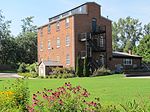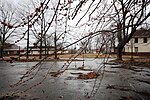Bowmanville GO Station
Future GO Transit railway stationsPages with no open date in Infobox stationProposed railway stations in CanadaRailway stations in the Regional Municipality of DurhamTransport in Clarington
Bowmanville GO Station is a planned GO Transit train station to be built by Metrolinx in the community of Bowmanville, Ontario. It will be the terminus station of GO Transit's approved expansion of train service on the Lakeshore East line and will become a transit hub for Durham Region Transit and GO Transit. According to a 2011 environmental impact assessment, the station would have about 770 parking spaces, a bus loop and a kiss and ride area on the south side of the station. The station will be located on the south side of CP Rail's Belleville Subdivision and, as a terminal, it will have two stub tracks.
Excerpt from the Wikipedia article Bowmanville GO Station (License: CC BY-SA 3.0, Authors).Bowmanville GO Station
Prince William Boulevard, Clarington
Geographical coordinates (GPS) Address Nearby Places Show on map
Geographical coordinates (GPS)
| Latitude | Longitude |
|---|---|
| N 43.9075 ° | E -78.703611111111 ° |
Address
GO - Bowmanville Carpool Lot
Prince William Boulevard
L1C 0A1 Clarington
Ontario, Canada
Open on Google Maps








